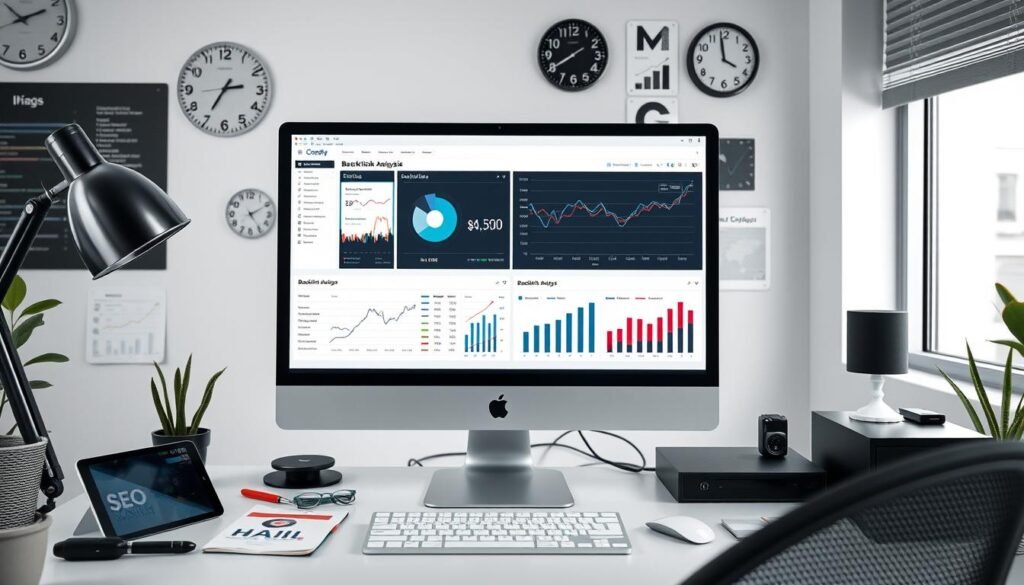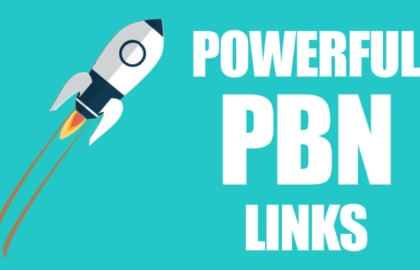What is a Backlink in SEO? Did you know a single backlink can be worth thousands of dollars in SEO value? A well-placed inbound link can greatly improve your website’s search engine rankings. As an SEO expert, I’m here to explain the importance of backlinks and how they can change your digital marketing strategy.

Key Takeaways
- Backlinks are crucial for building website authority and improving search engine rankings.
- Understand the difference between natural and artificial backlinks, and focus on creating a healthy, diverse backlink profile.
- Explore various backlink building strategies, from guest posting to broken link building, to grow your inbound links.
- Analyze your competitors’ backlink profiles to identify opportunities and avoid potential pitfalls.
- Utilize backlink analysis tools to monitor and manage your link portfolio for optimal SEO performance.
What is a Backlink in SEO?
Backlinks are key in search engine optimization (SEO). Simply put, a backlink is a link from one website to another. These links help decide a website’s authority and its ranking in search engines.
Natural vs. Artificial Backlinks
There are two types of backlinks: natural and artificial. Natural backlinks come from high-quality content that others link to. They are the most valuable and genuine. Artificial backlinks are made through strategies like guest posting or link exchanges. While they help, search engines see them as less trustworthy.
The Role of Backlinks in Website Authority
Backlinks play a big role in search engine algorithms. They show a website’s credibility and authority. The more quality links a site has, the more trustworthy it seems to search engines. This can lead to better rankings, more visibility, and more traffic.
“Backlinks are the foundation of a successful SEO strategy. They not only boost your website’s authority but also drive valuable referral traffic.”
The Evolution of Backlinks in Search Engine Optimization
The role of backlinks in SEO has changed a lot over time. In the early days, search engines used backlinks to judge a website’s authority. This led to fake link-building, like link farming and reciprocal linking.
Now, search engines like Google look at the link juice and link authority of backlinks more. They care about the credibility and relevance of the sites linking back. This means the quality of backlinks matters more than how many there are.
“The quality and relevance of backlinks have become far more important than the sheer quantity of links pointing to a website.”
Today, SEO aims for a natural, high-quality backlink profile. This means creating valuable content, forming partnerships, and getting mentions from influencers. These efforts show a website’s true value and authority.

As search engines keep improving, backlinks in SEO will keep evolving. To stay ahead, it’s important to understand these changes and adapt to new link building strategies.
Why Backlinks Matter for Your SEO Strategy
As an SEO pro, I stress how vital backlinks are for online success. Backlinks, or links to your site from other sites, boost your site’s authority and rankings. We’ll look at the benefits of quality backlinks and how they shape your SEO strategy.
Direct SEO Benefits of Quality Backlinks
Getting links from trusted sites can greatly improve your website’s profile. These links show search engines your content is valuable and reliable. More quality backlinks mean more authority, better visibility, and higher rankings in search results.
Indirect Benefits for Brand Authority
Backlinks also boost your brand’s authority and trustworthiness. When your content appears on respected sites, it makes your brand a leader. This can increase brand recognition, customer trust, and lead to more sales.
Impact on Search Engine Rankings
Backlinks have a huge impact on search rankings. Search engines like Google value the quality and number of backlinks to a site. More quality backlinks mean better rankings, more organic traffic, and more sales.
| Backlink Metric | Description | Impact on SEO |
|---|---|---|
| Quantity | The total number of backlinks pointing to your website | More backlinks generally lead to higher search engine rankings |
| Quality | The authority and relevance of the websites linking to your site | High-quality, relevant backlinks have a stronger positive impact on rankings |
| Diversity | The variety of referring domains and anchor text used in backlinks | A diverse backlink profile is seen as more natural and trustworthy by search engines |
Backlinks are key to a strong SEO strategy. Building a diverse, high-quality link profile boosts your site’s visibility and authority. This leads to better performance in search engine results.
Understanding Link Equity and Link Juice
In the world of SEO, two key concepts are link equity and link juice. They might seem mysterious, but they’re crucial for boosting your website’s link authority and link popularity.
Link equity is the value or “power” a backlink gives to a website. The more authoritative the linking site, the higher the link equity. This power is called “link juice,” which helps improve your site’s rankings and visibility.
Think of it like a water pipe. The more water (link equity) flowing, the more it can help the site it’s connected to (link juice). Good backlinks are like these powerful pipes, bringing valuable link juice to your site.
| Attribute | High Link Equity | Low Link Equity |
|---|---|---|
| Link Relevance | Highly relevant to your content | Irrelevant or unrelated |
| Link Authority | From an authoritative, high-domain-authority website | From a low-authority or spammy website |
| Link Type | Dofollow links that pass link juice | Nofollow links that don’t pass link juice |
| Link Placement | Within the content, not in the sidebar or footer | In the sidebar, footer, or other low-value areas |
Understanding link equity and link juice helps you build a strong link authority profile. This can take your website to the top of search engine rankings. The goal is to get high-quality, contextual backlinks from trusted sources. This approach will greatly benefit your SEO efforts.

Different Types of Backlinks and Their Value
SEO is all about the quality of backlinks. It’s important to know the value of each type. Let’s explore do-follow, no-follow, editorial, and user-generated backlinks.
Do-Follow vs. No-Follow Links
Do-follow links are the best for SEO. They pass authority to your site. Search engines follow these links to check your site’s ranking.
No-follow links don’t pass authority but still help with traffic. They don’t affect your site’s ranking.
Editorial vs. User-Generated Links
Editorial links come from quality content others link to. They show search engines your content is valuable. User-generated links, like comments, have less value.
It’s key to balance these backlinks for a strong profile. Knowing their differences helps you choose the best links for your site.
“The key to building a robust backlink profile is to focus on acquiring high-quality, contextual links from reputable, relevant sources.”
Building a Natural Backlink Profile
As an SEO pro, I know how key a natural backlink profile is for your site. Link building is a big part of off-page SEO. It can really help your site show up online and rank better. But, you must do it right to avoid trouble with Google.
Creating a natural backlink profile means focusing on quality, not just getting lots of links. It’s better to get a few good, relevant links than many bad ones. These links make your site look better and tell search engines your content is worth more.
One good way is to make linkable assets like helpful blog posts or guides. Share these with people in your field and online communities. This can lead to natural backlinks. Also, writing for other reputable sites can help build your backlink profile.
It’s also important to get links from different places. Don’t just get links from one source, as this can look bad to search engines. Mix up do-follow and no-follow links, and get links from articles and user content. This shows your SEO efforts are real and lasting.
| Link Type | Value | Example |
|---|---|---|
| Do-Follow Links | High | Guest posts, editorial mentions |
| No-Follow Links | Moderate | Social media shares, forum comments |
| Editorial Links | High | Mentions in industry publications |
| UGC Links | Moderate | Product reviews, testimonials |
By using these strategies and keeping an eye on your backlinks, you can build a strong off-page SEO plan. Remember, good link building takes time and effort. But, it’s worth it for your site’s authority and rankings.

“The key to building a natural backlink profile is to focus on quality over quantity and diversify your link sources.”
Common Backlink Building Strategies That Work
In the world of SEO, a strong backlink profile is key. It helps your website rank better in search results. There are many ways to get backlinks, but some are more effective than others. Let’s look at a few strategies that can boost your SEO.
Guest Posting and Content Partnerships
Guest posting and content partnerships are great for getting quality backlinks. By writing valuable content for other websites, you show your expertise. You also get backlinks from trusted sources. This strategy helps you reach more people and build your brand.
Broken Link Building Techniques
Broken link building is another effective tactic. It involves finding broken links on websites and offering your content as a replacement. This way, you get a backlink that improves your site’s visibility. It takes some effort, but it’s worth it.
Using strategies like guest posting, content partnerships, and broken link building can strengthen your backlink profile. The secret to success is creating content that adds value to your audience.
How to Analyze Your Competitor’s Backlinks
Looking at your competitors’ backlinks can give you great insights. It helps you see what’s working for them and how you can get similar backlinks. This can improve your website’s authority and rankings.
Here’s how to analyze your competitor’s backlink profile:
- Identify Your Competitors: First, find the main players in your field. These are sites that rank well for the keywords you want.
- Use Backlink Analysis Tools: Tools like Ahrefs, Majestic, or Moz can help. They show you the quality and types of backlinks your competitors have.
- Analyze the Link Profiles: Look at your competitors’ backlinks for patterns. Check for top referring domains, anchor text, and link types.
- Identify Link Building Opportunities: Find chances to get similar backlinks. This might mean guest posting or creating linkable content.
- Monitor and Adapt: Keep an eye on your competitors’ backlinks. Change your strategy as needed to stay ahead.
By studying your competitors’ backlinks, you can learn a lot. You can improve your own backlink analysis and link profile strategy. This can boost your website’s visibility and authority.
| Tool | Key Features | Pricing |
|---|---|---|
| Ahrefs | – Comprehensive backlink analysis – Keyword research – Site audit | $99/month (Lite plan) |
| Majestic | – Link intelligence data – Backlink history – Site explorer | $49.99/month (Lite plan) |
| Moz | – Link analysis – Keyword research – Site explorer | $99/month (Standard plan) |

“Analyzing your competitors’ backlink profiles is like peeking into their playbook – it reveals the strategies that are working for them and gives you a roadmap to outshine them in the search engine results.”
Tools for Monitoring and Managing Backlinks
In today’s SEO world, knowing and managing your website’s backlinks is key. Luckily, many strong tools help you tackle this important part of your online strategy.
Popular Backlink Analysis Tools
For backlink analysis, top tools like Ahrefs, Moz, and Semrush give deep insights into your link profile. They let you see where your backlinks come from, check their quality, and find new link chances. Using these tools, you can understand your backlink situation better and improve your SEO.
Tracking Backlink Performance
It’s also vital to watch how your backlinks perform. Google Search Console and SEMrush offer live data, helping you see how your backlink analysis and link profile work. You can track things like referral traffic, domain authority, and ranking changes to see if your backlink plans are working.
By using these backlink analysis tools and keeping an eye on your link profile, you can make smart choices to boost your SEO. This will help your online success last over time.

“The key to successful backlink management is to constantly monitor, analyze, and optimize your website’s link profile.”
Avoiding Toxic Backlinks and Penalties
In the world of search engine optimization, link building is key. It helps improve your website’s link authority and profile. But, not all backlinks are good. Some can harm your site’s rankings and visibility.
To stay safe, watch your link profile closely. Look for any bad backlinks. These are unnatural or spammy links that search engines might penalize.
Regular link audits are important. They help you check the quality and source of your links. Watch out for low-quality, irrelevant, or suspicious-looking sites linking to you.
- Identify and remove any toxic backlinks, such as links from link farms, private blog networks, or websites with questionable content.
- Disavow any backlinks that you cannot remove, notifying search engines that you do not endorse these links.
- Focus on building a natural, high-quality link profile by creating valuable content, engaging in guest posting, and leveraging social media platforms.
By managing your link profile well, you can avoid penalties. Quality links are more important than quantity. This is the secret to successful link building.
“The key to successful link building is to focus on creating high-quality, relevant content that others will naturally want to link to, rather than engaging in spammy or manipulative tactics.”
Being careful with your link profile is crucial. Use ethical link building strategies. This way, your website can keep growing in the changing world of SEO.
Link Earning vs. Link Building: What’s the Difference?
In the world of search engine optimization (SEO), link earning and link building often get mixed up. Many marketers find it hard to tell them apart. Both aim to boost a website’s authority and visibility, but they go about it differently. Let’s look at the main differences between link earning and link building.
Creating Linkable Assets
Link earning is about making content that others want to link to. This could be detailed guides, original research, interactive tools, or cool infographics. The goal is to create linkable assets that offer real value to your audience. This encourages them to share and link back to your site.
Outreach Strategies That Work
Link building, on the other hand, means actively seeking backlinks through outreach. This might include guest posting, influencer marketing, fixing broken links, and partnerships. The aim is to build relationships and get link placements that boost your site’s rankings and visibility.
Link earning is a more passive, content-focused method. Link building, however, needs a proactive, outreach-based approach. The best SEO plans mix both link earning and link building. This creates a strong backlink profile that appeals to users and search engines alike.
“The most effective SEO strategies leverage the power of both link earning and link building to establish a strong online presence and drive sustainable growth.”
Measuring Backlink Success and ROI
It’s important to track how well your backlink strategy is doing. This helps improve your SEO and shows the value of your investment. By looking at your backlink profile, you can see how your link-building is working. This helps you make better choices to boost your search rankings.
Focus on your backlink analysis. Look at the quality, number, and variety of links to your site. Tools like Ahrefs, Moz, and Semrush give detailed reports. They show you who links to you, what they say, and how strong those sites are.
| Metric | Description | Importance |
|---|---|---|
| Total Backlinks | The total number of links pointing to your website | Indicates the overall size and reach of your backlink profile |
| Referring Domains | The number of unique domains linking to your site | Reflects the diversity and authority of your backlinks |
| Domain Authority (DA) | A score that predicts how well a website will rank on search engine results pages (SERPs) | Higher DA backlinks contribute more to your website’s authority |
| Anchor Text | The visible, clickable text in a hyperlink | Helps identify the relevance and contextual fit of your backlinks |
By watching these metrics, you can see if your backlink plan is working. You can then tweak your link building to do better. Also, figuring out your backlink ROI shows the real benefits to your business.
Measuring your backlink success is key to bettering your SEO. By keeping an eye on your analytics, you make sure your link-building is effective. This helps reach your digital marketing goals.
Future Trends in Backlink Strategy
The digital world is always changing, and so are the ways we build backlinks. Experts in off-page SEO are watching new trends closely. These trends will shape how we get backlinks in the future.
Now, there’s a big push for quality over quantity in backlinks. Search engines can spot and punish low-quality links better than before. Marketers are now aiming for high-authority, contextual links. These links improve the user experience and show a site’s credibility.
Digital PR and influencer marketing are becoming key in link building. By working with industry leaders, businesses can get valuable link building opportunities. This helps them reach more people.
The rise of user-generated content (UGC) and social media platforms is also important. Brands are building online communities. They want natural backlinks from their audience.
As off-page SEO keeps evolving, staying ahead is key for success. By following these trends and adjusting strategies, businesses can thrive in the competitive SEO world.
“The future of link building lies in creating truly remarkable, shareable content that earns natural, high-quality backlinks from authoritative sources.”
Common Backlink Building Mistakes to Avoid
As an SEO pro, I’ve seen how backlinks affect a site’s ranking. It’s key to dodge common mistakes that can hurt your SEO. Here, I’ll share the most common link building errors and how to avoid them.
One big mistake is chasing quantity over quality in backlinks. Getting lots of links might seem good, but focus on high-quality, relevant backlinks from trusted sites. Spamming forums or low-quality directories can harm your rankings.
Another error is ignoring anchor text optimization. Anchor text is the text in a link that shows its relevance. Using too much exact-match or keyword-rich text can look unnatural and get you penalized.
Not monitoring and disavowing toxic backlinks is another mistake. It’s important to check your backlinks often and remove spammy ones to keep your site healthy.
Lastly, don’t rely too much on automated link building tools or services. These tools can create bad links. Focus on manual, contextual link building that follows search engine rules.
By avoiding these mistakes and building a strong backlink profile, you can boost your website’s growth. Focus on quality over quantity in your off-page SEO strategy.
Conclusion
Backlinks are key to a good SEO plan. Links from trusted sites boost your site’s authority and rankings. This brings more visitors to your site.
Building links through guest posts, fixing broken links, or creating shareable content is vital. It helps your brand shine online. Knowing about different links, keeping an eye on your link profile, and avoiding bad links is important.
Backlinks are very important for SEO. As search rules change, keeping up with link building is crucial. By following the latest trends, your site can succeed in the fast-paced world of SEO.
FAQ
What is a backlink in SEO?
A backlink is a link from one website to another. It’s key in SEO because it shows search engines your site is trusted and relevant.
What is the difference between natural and artificial backlinks?
Natural backlinks come from genuine sources like content partnerships. Artificial backlinks are bought or created unnaturally, which search engines don’t like.
How do backlinks contribute to a website’s authority?
Backlinks help show a website’s quality and relevance. Search engines use them to rank websites. More quality backlinks mean more authority.
How has the role of backlinks in SEO evolved over time?
Backlinks were once just about quantity. Now, it’s about quality and relevance. Search engines have gotten smarter.
Why do backlinks matter for my SEO strategy?
Backlinks boost your rankings, authority, and brand visibility. They’re essential for a strong off-page SEO strategy.
What is link equity and link juice, and how do they impact SEO?
Link equity or “link juice” is the value a backlink gives to a website. More authoritative links mean better rankings and SEO performance.
What are the different types of backlinks, and how do they differ in value?
Do-follow links help your authority, while no-follow links don’t. Editorial links are more valuable than user-generated ones.
How can I build a natural backlink profile?
Create valuable content that others want to link to. Use guest posting, broken link building, and create linkable assets. Focus on earning links naturally.
What are some common backlink building strategies that work?
Guest posting, content partnerships, and broken link building are effective. They help earn quality backlinks for better SEO.
How can I analyze my competitors’ backlinks?
Use tools to see your competitors’ backlinks. This helps you find opportunities to improve your own link profile.
What tools can I use to monitor and manage my backlinks?
Tools like Ahrefs, Moz, and SEMrush help track your backlinks. They show changes and alert you to issues.
How can I avoid toxic backlinks and penalties?
Regularly check your backlinks and remove bad ones. Focus on building a diverse, natural link profile.
What is the difference between link earning and link building?
Link earning is creating content that attracts links naturally. Link building is actively getting links through outreach. A good strategy combines both.
How can I measure the success and ROI of my backlink strategy?
Track metrics like referring domains and rankings. This helps you see if your strategy is working and make improvements.
What are the future trends in backlink strategy?
Focus on creating valuable content that earns links naturally. Digital PR, influencer marketing, and linkable assets will become more important.
What are some common backlink building mistakes to avoid?
Avoid buying links, engaging in schemes, and using low-quality links. Focus on a natural, diverse link profile to avoid penalties.






